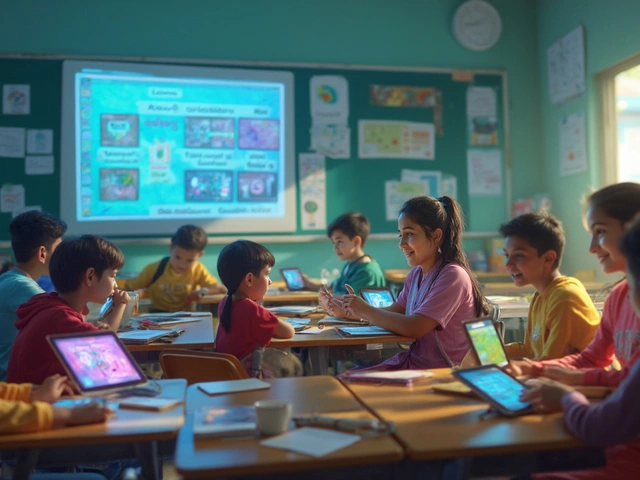Ever wondered what exactly goes on behind the scenes before someone becomes a fully-fledged teacher? It's not just about knowing your ABCs or being able to solve math problems off the top of your head. A teacher in training goes through a journey filled with learning new techniques, discovering the essence of classroom management, and figuring out how to inspire a classroom full of curious minds.
Think of it like a boot camp for educators. Trainees dive deep into understanding different learning styles, so they can personalize their teaching approach. They're equipped with strategies to maintain discipline without putting on the drill sergeant hat. It's about striking the right balance between being firm and being approachable, a skill that’s crucial when dealing with young scholars.
- The Heart of Teacher Training
- Key Skills Developed
- Challenges and How to Overcome Them
- The Role of Mentorship
- Innovative Teaching Methods
- Preparing for the Classroom
The Heart of Teacher Training
At the core of becoming a successful educator lies the intense experience of teacher training. This phase isn’t just about learning theories or cramming educational psychology jargon. It’s about experiencing the real rhythm of a classroom and learning how to adapt on the fly.
The journey kicks off with a robust curriculum designed to instill the essential skills a teacher needs. Trainees immerse themselves in lesson planning, which is all about crafting engaging and effective lessons that cater to various learning styles. Understanding how students learn is a cornerstone of education training, leading to more personalized learning experiences.
- Understanding different teaching models - whether it’s Montessori, traditional, or tech-driven methods.
- Learning to use technology in the classroom to enhance lessons and provide rich, diverse learning materials.
- Mastering the art of classroom management, which involves keeping students on task while nurturing a positive learning environment.
One surprising part of this training is the focus on emotional intelligence. It’s about recognizing and managing not only students’ emotions but their own too. After all, teaching can be as taxing as it is rewarding.
A vital aspect of teacher in training programs is the hands-on experience. Whether through student teaching placements or simulations, trainees get to practice what they’ve learned in an actual classroom setting. This practical exposure helps them build confidence and adapt theoretical knowledge to real-world scenarios.
Programs typically take around a year of committed study, but this varies. Some programs offer accelerated routes, while others combine part-time work with studies, especially helpful for those switching careers into teaching.
While the process is demanding, the rewards are immense. Completing training with a sound understanding of educational theory, paired with practical experience, is what helps budding teachers step confidently into their classrooms, ready to make a real difference.
| Program Duration | Average Hours |
|---|---|
| Traditional | 800+ hours |
| Accelerated | Approximately 600 hours |
| Part-Time | Varies but often split across terms |
Key Skills Developed
Being a teacher in training is about picking up a whole toolkit of skills that you never really put down. First off, let's talk about communication. It’s all about knowing how to explain complex ideas in a way that even the most distracted student can understand. In training, future teachers practice crafting clear, engaging lectures that keep students hooked.
Another biggie is classroom management. From organizing desks to managing disruptions, trainees learn the ropes of how to keep a class running smoothly. This often includes strategies for creating a positive learning environment and handling conflicts calmly.
Time management can't be overlooked. Teachers juggle lesson planning, grading, and spontaneous events. Training programs typically drill time-management techniques into trainees so they can handle these demands without burning out.
They also dive deep into assessment and evaluation. It's not just about grading papers; it's understanding how to measure student progress and adapt teaching methods accordingly.
And let's not forget about tech skills. With classrooms going digital, teachers in training are learning to use educational software, interactive whiteboards, and other tech tools to make learning fun and interactive.
| Skill | Description |
|---|---|
| Communication | Ability to convey information effectively. |
| Classroom Management | Maintaining a productive learning environment. |
| Time Management | Efficiently scheduling tasks and duties. |
| Assessment & Evaluation | Analyzing student performance and adapting teaching methods. |
| Technology Integration | Using tech tools to enhance learning experiences. |
These aren't just academic concepts; they're practical skills that trainees practice day in and day out, preparing them for the unpredictable yet rewarding life of teaching.
Challenges and How to Overcome Them
Becoming a teacher in training isn’t always a walk in the park. Many trainees face hurdles that can feel daunting at first. Let's shine a light on some of these common challenges and practical ways to tackle them.
One major hurdle is juggling multiple responsibilities. Between lesson planning, attending classes, and getting hands-on classroom experience, it can feel like there's never enough time. Procrastination becomes the enemy here. The solution? Time management is key. Break tasks into smaller, manageable chunks and tackle them step by step. Use a planner or digital calendar to keep everything on track and prioritize what's urgent.
Another challenge is classroom management, especially for those new to the teaching world. Picture this: you're standing in front of a bustling room full of energetic students. How do you keep things orderly? Try setting clear rules from day one. Consistency is essential, and establishing routines helps students know what to expect. Don’t forget to keep things positive by acknowledging good behavior—it goes a long way.
Handling diverse learning needs can also be tough. Students have varied backgrounds and abilities, so a one-size-fits-all approach won't work. It's about being flexible and ready to adapt your teaching style. Consider using different teaching tools like visual aids, interactive activities, or tech-based resources to appeal to different learning preferences.
Lastly, confidence can sometimes waver, especially when facing a room full of expectant faces. Building confidence takes time, but remember, everyone starts somewhere. Practice makes perfect. Don't shy away from feedback, and if a lesson doesn't go as planned, learn from it and move on.
These challenges might feel overwhelming at the start, but each one offers a chance to learn and grow. By actively engaging with and finding solutions for these hurdles, those in education training can develop into well-rounded, adaptable educators ready to face the classroom.

The Role of Mentorship
Mentorship plays a huge part in shaping aspiring educators during their teacher training. Think of mentors as the seasoned guides who help trainees navigate the complex world of teaching. They're like the Yodas to our young Skywalkers, imparting wisdom and sharing insider tips that aren't found in textbooks.
A mentor can make all the difference by offering real-world insights and setting an example of effective teaching strategies. They provide valuable feedback, which helps trainees fine-tune their skills before stepping into their own classrooms. This practice isn't just about pointing out what could be better; it's about recognizing strengths and building confidence.
"A good mentor teaches not just the curriculum but also instills a love for learning," says Linda Darling-Hammond, a professor of education. This speaks to the heart of mentorship—encouraging passion in every aspiring teacher.
Mentors also introduce innovative teaching methods, helping trainees adapt to changing educational needs. With tech integration becoming crucial, mentors often guide on using educational tools that make learning engaging and effective.
Moreover, having a supportive mentor can help trainees manage initial challenges, like classroom management or lesson planning. It’s easier to tackle these hurdles with someone who's been through it all. A solid mentor-mentee relationship can evolve into lasting professional connections, benefiting both parties throughout their careers.
Statistically, new teachers who have had mentoring programs tend to stay in the profession longer and show improved teaching effectiveness. A report from the National Council on Teacher Quality mentions that retention rates increase by up to 20% when mentorship is part of teacher training. It highlights just how impactful these relationships can be.
Let's be honest, teaching is as much about learning as it is about teaching. Through mentorship, not only do newbies gain valuable skills, but mentors themselves stay sharp and updated with fresh perspectives, making it a win-win for both.
Innovative Teaching Methods
Gone are the days when teaching meant standing in front of a chalkboard all day. Today's teacher training programs emphasize using innovative teaching methods to make learning more dynamic and engaging. These methods are not just about techy gadgets; they're about creating a more interactive and personalized learning experience for students.
One popular approach making waves is blended learning, which combines traditional face-to-face instruction with online activities. This model allows students to pace their learning and reinforces concepts through digital platforms. Trainees learn to use learning management systems (LMS) and educational apps, helping students access resources anytime, anywhere.
Then there's gamification, a method that incorporates game-like elements into the learning process. Teachers in training are taught to design activities that promote competition and rewards, motivating students to participate actively. Imagine using a point system for homework or quizzes—it's a game-changer!
Role-playing and simulation are other techniques where students mimic real-world scenarios. For instance, history lessons might become time-travel adventures to ancient civilizations. Trainee teachers are encouraged to create these immersive experiences, fostering deeper understanding and retention of the subject matter.
Project-based learning (PBL) is gaining traction too. Instead of traditional exams, students tackle real-world problems in projects that span weeks or months. Teacher training programs focus on guiding trainees to effectively manage and assess these projects, which help students develop critical thinking and collaboration skills.
- Blended Learning: Combines classroom teaching with online resources.
- Gamification: Uses games to make learning interactive and fun.
- Role-playing: Allows students to learn by doing through simulated exercises.
- Project-based Learning: Focuses on student-driven projects addressing real-world issues.
The combination of these methods equips future educators with tools to cater to diverse learning needs and to create a positive and effective classroom environment. This kind of forward-thinking approach ensures that new teachers are not only ready to handle today's classroom dynamics but are also prepared to adapt as education evolves.
Preparing for the Classroom
So, you're gearing up to take on the classroom and shape the minds of tomorrow. The path might seem a bit daunting at first, but it's full of eye-opening and fulfilling experiences. First off, knowing your subject matter inside and out is crucial, but that’s just where the journey starts. Understanding what kind of teaching methods resonate with different students can make or break a lesson.
One vital skill for any teacher in training is mastering the art of lesson planning. A well-structured lesson plan acts like a roadmap, guiding both you and your students through the day's material. Make sure your plans include a clear objective, engaging activities, and ways to assess student understanding. And hey, flexibility is your friend here—sometimes, the best teaching moments come from the unexpected.
Classroom management often feels like one of the biggest mountains to climb. Creating an environment that’s conducive to learning requires setting clear expectations and consistently maintaining them. Introducing interactive activities and being approachable helps build a rapport with students, making it easier to keep disruptions to a minimum.
Using technology has become a huge part of effective teaching. It's more than just sticking a PowerPoint slide on a projector. Interactive tools and platforms can make lessons more engaging. Tools like Kahoot or Google Classroom aren't just buzzwords; they're ways to meet students where they're at—digitally.
Oh, and let's not forget about the importance of feedback. Constructive feedback from mentors and peers can be a game changer. It offers insights you might not have considered and is essential for growth. Observations from seasoned teachers provide real-world advice that no textbook can offer.
Lastly, getting comfortable with self-reflection is essential. After each class, take a moment to ponder: What went well, what flopped, and what can be tweaked for next time? This process helps continuously fine-tune your skills and become a more effective educator.





